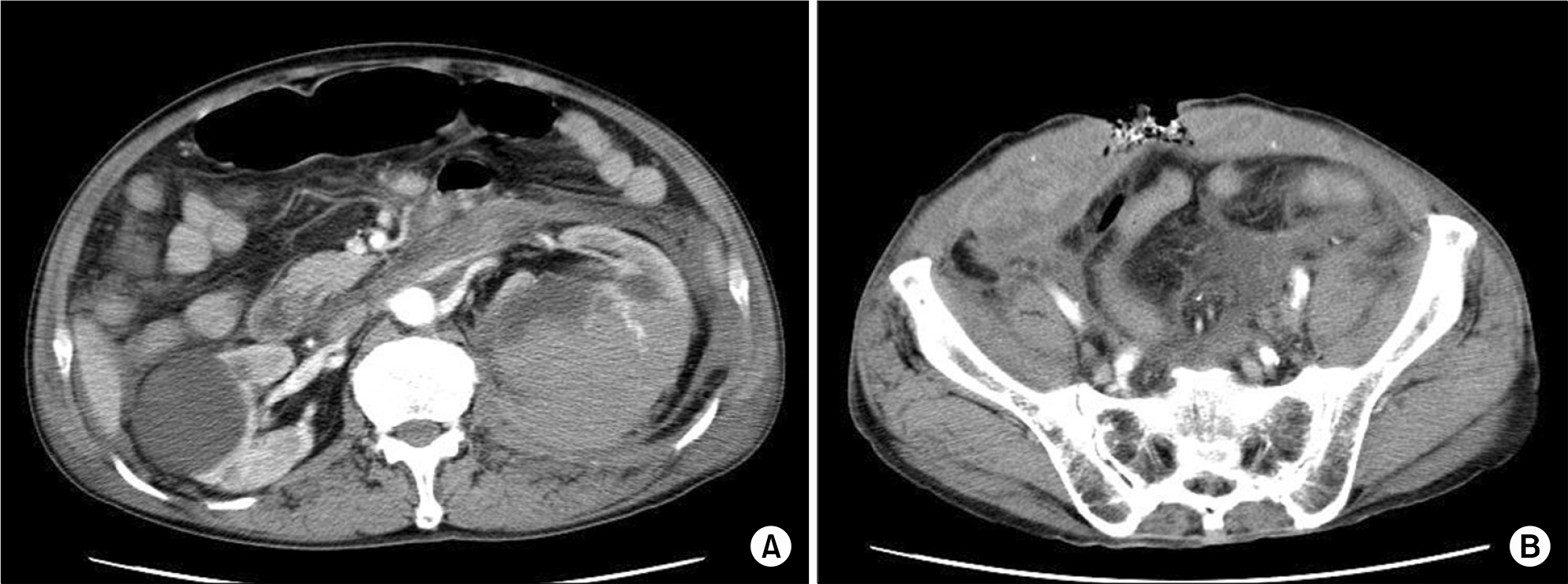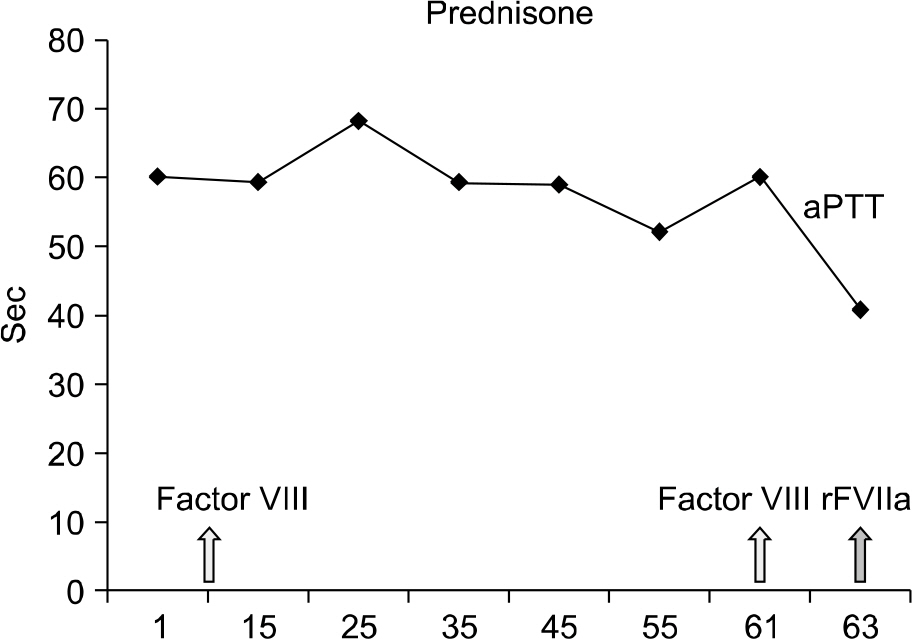Korean J Hematol.
2009 Sep;44(3):163-167. 10.5045/kjh.2009.44.3.163.
Post-operative Bleeding due to Acquired Hemophilia Successfully Treated with Recombinant Factor VIIa: Case Report
- Affiliations
-
- 1Department of Internal Medicine, Pusan National University School of Medicine, Pusan National University Hospital, Busan, Korea. porori701@hanmail.net
- KMID: 2252136
- DOI: http://doi.org/10.5045/kjh.2009.44.3.163
Abstract
- Acquired hemophilia is a rare but potentially life-threatening hemorrhagic disorder caused by the development of autoantibodies against coagulation factor VIII. Concentrates of human factor VIII, desmopressin, activated prothrombin complex concentrates, recombinant activated factor VII can all be used to control episodes of acute bleeding. The recent availability of bypassing agents like recombinant activated factor VII has been shown to be clinically safe and effective as treatment for acute bleeding. In this case report, a 67 year-old male patient with Rh negative blood type developed gross hematuria and bleeding after transurethral resection due to prostatic hypertrophy. After vesicocutaneous fistular reduction operation, post-operative bleeding was presented. The acute bleeding was controlled successfully by the combined treatment with recombinant activated factor VII (Novo seven(R)) and prednisone.
MeSH Terms
Figure
Cited by 1 articles
-
Characterization of anti-factor VIII antibody in a patient with acquired hemophilia A
Jisu Oh, Yeongmin Lim, Moon Ju Jang, Ji Young Huh, Midori Shima, Doyeun Oh
Blood Res. 2013;48(1):58-62. doi: 10.5045/br.2013.48.1.58.
Reference
-
References
1. Hay CR. Acquired haemophilia. Baillieres Clin Haematol. 1998; 11:287–303.2. Green D, Lechner K. A survey of 215 non-hemophilic patients with inhibitors to factor VIII. Thromb Haemost. 1981; 45:200–3.
Article3. Kondo E, Utsumi M, Hattori M, et al. Acquired factor VIII-specific antibody disorder accompanied by a life-threatening retroperitoneal hematoma. Intern Med. 1995; 34:901–3.
Article4. Ingerslev J. Hemophilia. Strategies for the treatment of inhibitor patients. Haematologica. 2000; 85:15–20.5. Hedner U, Erhardtsen E. Potential role for rFVIIa in transfusion medicine. Transfusion. 2002; 42:114–24.
Article6. HednerU. Glazer S, Falch J. Recombinant activated factor VII in the treatment of bleeding episodes in patients with inherited and acquired bleeding disorders. Transfus Med Rev. 1993; 7:78–83.7. Hay CR, Negrier C, Ludlam CA. The treatment of bleeding in acquired haemophilia with recombinant factor VIIa: a multicenter study. Thromb Haemost. 1997; 78:1463–7.8. Lee JJ, Chung IJ, Park MR, et al. Acquired hemophilia successfully treated with oral immunosuppressive therapy. Korean J Intern Med. 2000; 15:135–7.
Article9. Jung SW, Kim S, Youk CM, et al. A case of asymptomatic acquired hemophilia. Korean J Thromb Hemost. 2001; 8:59–62.10. Kim JH, Lee WI, Yoon HJ, et al. A case of acquired hemophilia A. J Lab Med Qual Assur. 2003; 25:207–9.11. Chung BH, Kim YJ, Kim MS, et al. A case of acquired hemophilia detected after influenza vaccination. Korean J Med. 2004; 66:298–301.12. Park SY, Kim JS, Kim Y, et al. Two cases of acquired hemophilia A successfully treated with oral steroid or danazol. Korean J Hematol. 2005; 40:58–63.
Article13. Song MH, Ahn SJ, Yoo SH, et al. Total Knee arthroplasty-associated acquired hemophilia: a case report. J Korean Orthop Assoc. 2006; 41:167–9.
Article14. Kim MS, Kilgore PE, Kang JS, et al. Transient acquired hemophilia associated with mycoplasma pneumonia pneumonia. J Korean Med Sci. 2008; 23:138–41.15. Ogata H, Sakai S, Koiwa F, et al. Plasma exchange for acquired hemophilia: a case report. Ther Apher. 1999; 3:320–2.
- Full Text Links
- Actions
-
Cited
- CITED
-
- Close
- Share
- Similar articles
-
- A Case of Desensitization for Hemophilia B Inhibitor Patient with Anaphylaxis to FIX Concentrates
- Recombinant Factor VIIa Treatment for Acute Intracerebral Hemorrhage
- Two Cases of Infant Hemophilia A Patients with Inhibitors
- A Case of Successful Treatment of Childhood Intractable Gastrointestinal Hemorrhage with Low Dose Recombinant Activated Factor VII (NovoSeven (R))
- Sequential therapy with activated prothrombin complex concentrates and recombinant activated factor VII to treat unresponsive bleeding in patients with hemophilia and inhibitors: a single center experience



